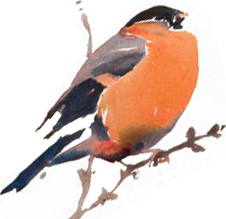Growing up in a small mining village in the central belt of Scotland, I was always looking for an adventure. Fortunately, I didn’t have far to travel! Over the years, the Forth has provided me with some amazing experiences – bird ringing with the Lothian Ringing Group across the Forth Isles, admiring waders, watching Bottlenose dolphins, Humpback Whales and even Orca – there is always something to see!
I have worked with seabirds since graduating from Edinburgh Napier University in 2011. I began working on the Farne Islands, then I worked for RSPB Scotland and a lottery-funded project on the Northumberland coast. In 2018, I got my dream job as a Seabird Scientist for the Ascension Island Government. The photo on the right shows an adult Sooty Tern, a species which nests on the island.

Ascension Island is found in the heart of the Atlantic, 7o south of the equator
Ascension Island is a remote volcanic island in the heart of the Atlantic Ocean, some 800 miles from neighboring Saint Helena. It is a UK Overseas Territory (UKOT) with a local island government (known as AIG). The AIG Conservation and Fisheries Directorate aims to safeguard Ascension’s unique biodiversity through effective long-term conservation management. Ascension is home to a number of endemic plants and animals as well as the second largest Green Turtle rookery in the Atlantic.

Green Turtle returning to the sea after laying
Ascension has 11 seabird species including the endemic Ascension Frigatebird. Other species include Masked, Brown and Red-footed Boobies; Brown and Black Noddies; Sooty and White Terns; Red-billed and White-tailed Tropicbirds, and the Madeiran Storm Petrel.

The Ascension Frigatebird. The males inflate a red gular pouch to attract a female (behind)

Two colour morphs of the Red-footed Booby nest on Ascension Island – the white morph (pictured) and a brown morph
Two endemic terrestrial species – the Ascension Rail and Heron – became extinct when cats were introduced to control the local rodent population. The seabirds were forced to nest on offshore islands and stacks, with the exception of the Sooty Tern, which nested in smaller and smaller numbers. In 2002, the RSPB worked alongside a number of partners to eradicate the feral cat population. The project was a great success and the number of seabirds nesting on the main island increases each year.
During the reign of the cats, Boatswainbird Island on the east coast of Ascension was the only remaining nesting site for the Ascension Frigatebird. Lying 300m from the main island, Boatswainbird remains predator free and is a seabird paradise. The flat top of the island is home to an estimated 5,000 pairs of frigatebirds while Masked Boobies nest in any other available ground. The steep cliffs of Boatswainbird provide excellent habitat for noddies and tropicbirds.

Boatswainbird Island (Ascension's version of the Bass Rock) is home to thousands of nesting seabirds. The Letterbox peninsula (left) is being recolonised by seabirds following a successful feral cat eradication programme
Since the feral cat eradication, the seabirds have recolonized the Letterbox peninsula, directly opposite Boatswainbird. Letterbox is now home to nesting frigatebirds, boobies, tropics and noddies. Here, we do productivity monitoring of frigatebirds and Masked Boobies, following individual nests from the egg being laid until the chick fledges. Together with an annual census, we can understand the variation and trends in the local seabird population.

Researchers monitor individual Masked Booby nests across the Letterbox peninsula, Ascension Island
In the southwest corner of Ascension is the Mars Bay and Waterside Fairs Nature Reserves, home to approximately 250,000 pairs of nesting Sooty Terns. These birds nest asynchronously, so the reserves are filled with prospecting pairs, incubating adults, small chicks and fledglings at any one time. After failing to “twitch” the Sooty Tern seen in Northumberland in the summer of 2018, it was a dream come true to see this incredible species in such dense numbers!

Sooty Terns nesting across the Waterside Nature Reserve
In 2019, the Ascension Island Marine Protected Area (MPA) was established, one of the largest MPA’s in the world. It protects 445,000km2 of ocean, creating a safe haven for our wildlife.
For updates on the work of the AIG Conservation and Fisheries Directorate, please follow us on Facebook or Twitter.
Laura Shearer
Seabird Conservation Scientist
Ascension Island Government
SOC member
Photos © Laura Shearer




